engine MITSUBISHI ECLIPSE CROSS 2018 Owner's Manual (in English)
[x] Cancel search | Manufacturer: MITSUBISHI, Model Year: 2018, Model line: ECLIPSE CROSS, Model: MITSUBISHI ECLIPSE CROSS 2018Pages: 417, PDF Size: 74.06 MB
Page 348 of 417
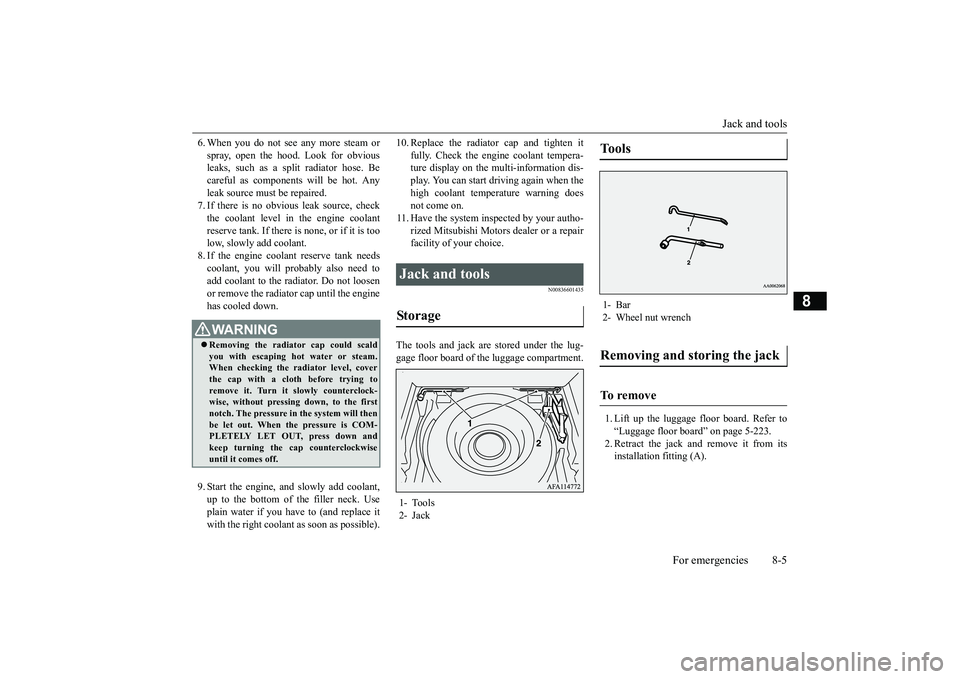
Jack and tools
For emergencies 8-5
8
6. When you do not see any more steam or spray, open the hood. Look for obvious leaks, such as a split radiator hose. Be careful as components will be hot. Anyleak source must be repaired. 7. If there is no obvious leak source, check the coolant level in the engine coolantreserve tank. If there is none, or if it is too low, slowly add coolant. 8. If the engine coolant reserve tank needscoolant, you will probably also need toadd coolant to the radiator. Do not loosen or remove the radiator cap until the engine has cooled down. 9. Start the engine, and slowly add coolant, up to the bottom of the filler neck. Useplain water if you have to (and replace it with the right coolant as soon as possible).
10. Replace the radiator cap and tighten it
fully. Check the engine coolant tempera- ture display on the multi-information dis- play. You can start driving again when thehigh coolant temperature warning does not come on.
11. Have the system inspected by your autho-
rized Mitsubishi Motors dealer or a repair facility of your choice.
N00836601435
The tools and jack are stored under the lug- gage floor board of the luggage compartment.
1. Lift up the luggage floor board. Refer to “Luggage floor board” on page 5-223. 2. Retract the jack and remove it from its installation fitting (A).
WA R N I N G Removing the radiator cap could scald you with escaping hot water or steam.When checking the radiator level, cover the cap with a cloth before trying to remove it. Turn it slowly counterclock-wise, without pressing down, to the first notch. The pressure in the system will then be let out. When the pressure is COM-PLETELY LET OUT, press down and keep turning the cap counterclockwise until it comes off.
Jack and tools Storage 1- Tools 2- Jack
Tools 1- Bar2- Wheel nut wrenchRemoving and storing the jack To remove
BK0252700US.bo
ok 5 ページ 2017年10月4日 水曜日 午後4時54分
Page 349 of 417

How to change a tire 8-6 For emergencies
8
1. Retract the jack, then return it to its origi- nal position.2. Extend the jack and firmly secure it in its storage area, then lo
wer the luggage floor
board.
N00836901904
Before changing a tire, first stop your vehiclein a safe, flat location. 1. Park the vehicle on level and stable ground. 2. Set the parking brake firmly. 3. Move the selector lever to the “P”(PARK) position and turn the ignitionswitch (the engine switch) to the “OFF” position. 4. Turn on the hazard warning flashers andset up a warning sign, such as a warning triangle or flashing signal lights, at an adequate distance from the vehicle, andhave all your passengers leave the vehicle. 5. To prevent the vehicle from rolling when it is raised on the jack, place chocks orblocks (A) at the tire that is diagonally opposite from the tire (B) you are chang- ing.
6. Get the jack, bar and wheel nut wrench ready. (Refer to “Jack and tools” on page 8-5.)
To s t o r e
To r e t r a c tTo r e t r a c t
To e x t e n d
How to change a tire
WA R N I N G Be sure to apply chocks or blocks to the correct tire when jacking up the vehicle. If the vehicle moves while jacked up, thejack could slip out of position, leading to an accident.NOTE
The chocks shown in the illustration do not come with your vehicle. It is recommended that you purchase chocks or blocks and keep them in the vehicle for use if needed. If chocks or blocks are not available, use stones or any other objects that are largeenough to hold the wheel in position.
BK0252700US.bo
ok 6 ページ 2017年10月4日 水曜日 午後4時54分
Page 352 of 417
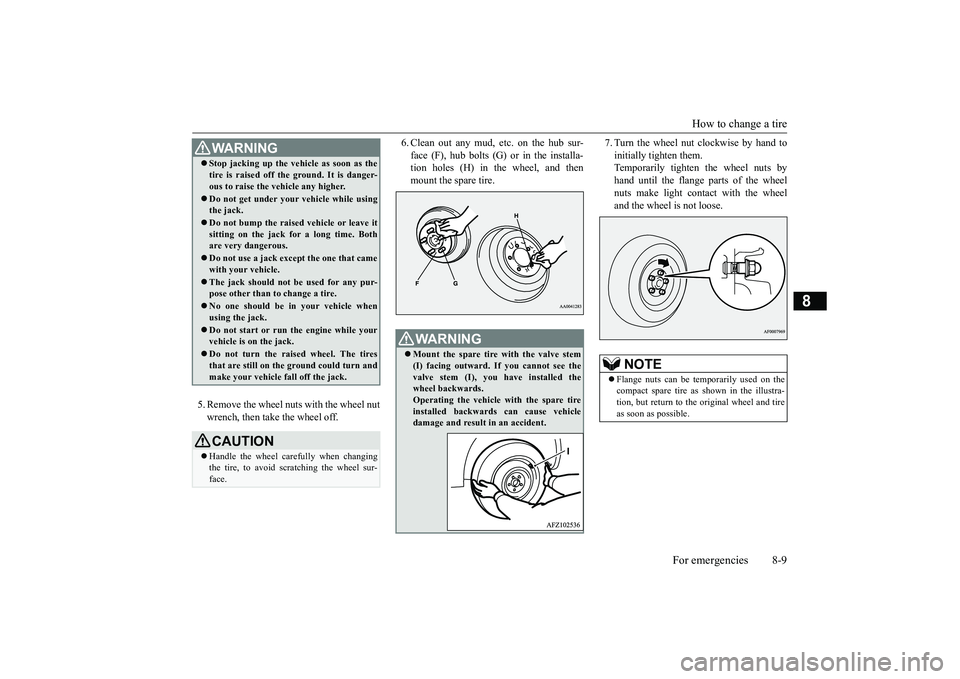
How to change a tire
For emergencies 8-9
8
5. Remove the wheel nuts with the wheel nut wrench, then take the wheel off.
6. Clean out any mud, etc. on the hub sur- face (F), hub bolts (G) or in the installa- tion holes (H) in the wheel, and then mount the spare tire.
7. Turn the wheel nut clockwise by hand to initially tighten them. Temporarily tighten the wheel nuts by hand until the flange parts of the wheelnuts make light contact with the wheel and the wheel is not loose.
WA R N I N G Stop jacking up the vehicle as soon as the tire is raised off the ground. It is danger- ous to raise the vehicle any higher. Do not get under your vehicle while using the jack. Do not bump the raised vehicle or leave it sitting on the jack for a long time. Both are very dangerous. Do not use a jack except the one that came with your vehicle. The jack should not be used for any pur- pose other than to change a tire. No one should be in your vehicle when using the jack. Do not start or run the engine while your vehicle is on the jack. Do not turn the raised wheel. The tires that are still on the ground could turn and make your vehicle fall off the jack.CAUTION Handle the wheel carefully when changing the tire, to avoid scratching the wheel sur- face.
WA R N I N G Mount the spare tire with the valve stem (I) facing outward. If you cannot see the valve stem (I), you have installed the wheel backwards.Operating the vehicle with the spare tire installed backwards can cause vehicle damage and result in an accident.
NOTE
Flange nuts can be temporarily used on the compact spare tire as shown in the illustra- tion, but return to the original wheel and tire as soon as possible.
BK0252700US.bo
ok 9 ページ 2017年10月4日 水曜日 午後4時54分
Page 355 of 417
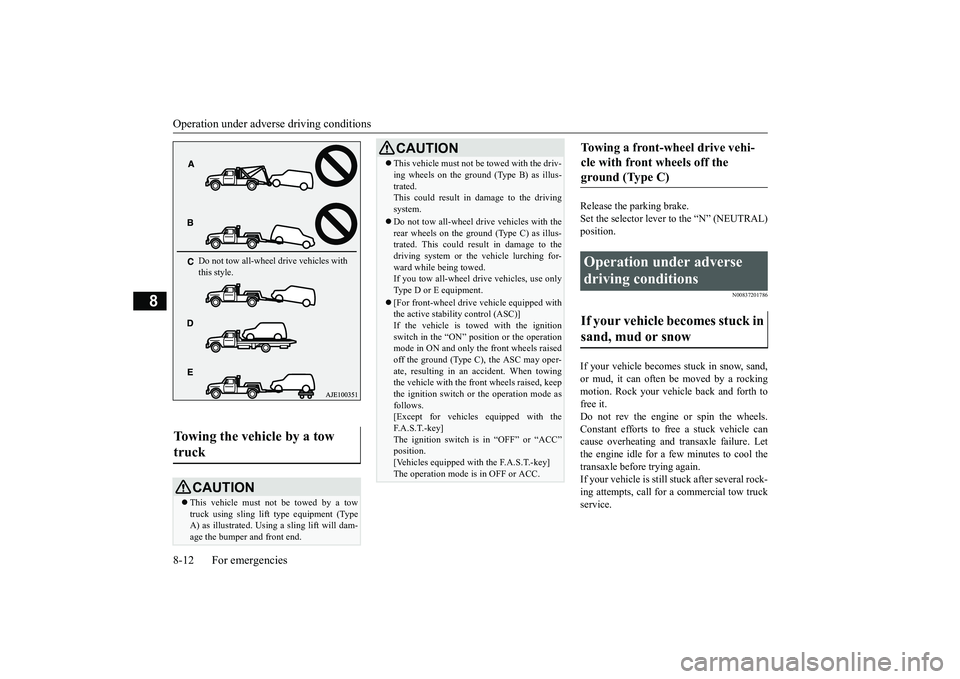
Operation under adverse driving conditions 8-12 For emergencies
8
Release the parking brake. Set the selector lever to the “N” (NEUTRAL) position.
N00837201786
If your vehicle becomes stuck in snow, sand,or mud, it can often be moved by a rocking motion. Rock your vehicle back and forth tofree it. Do not rev the engine or spin the wheels. Constant efforts to free a stuck vehicle cancause overheating and transaxle failure. Let the engine idle for a few minutes to cool the transaxle before trying again.If your vehicle is still stuck after several rock- ing attempts, call for a commercial tow truck service.
Towing the vehicle by a tow truck
CAUTION This vehicle must not be towed by a tow truck using sling lift type equipment (Type A) as illustrated. Using a sling lift will dam-age the bumper and front end.Do not tow all-wheel drive vehicles with this style.
This vehicle must not be towed with the driv- ing wheels on the ground
(Type B) as illus-
trated. This could result in damage to the driving system. Do not tow all-wheel drive vehicles with the rear wheels on the ground (Type C) as illus-trated. This could result in damage to the driving system or the vehicle lurching for- ward while being towed.If you tow all-wheel drive vehicles, use only Type D or E equipment. [For front-wheel drive vehicle equipped with the active stability control (ASC)] If the vehicle is towed with the ignitionswitch in the “ON” position or the operation mode in ON and only the front wheels raised off the ground (Type C), the ASC may oper-ate, resulting in an accident. When towing the vehicle with the front wheels raised, keep the ignition switch or the operation mode asfollows. [Except for vehicles equipped with the F. A . S . T. - k e y ]The ignition switch is in “OFF” or “ACC” position. [Vehicles equipped with the F.A.S.T.-key] The operation mode is in OFF or ACC.CAUTION
Towing a front-wheel drive vehi- cle with front wheels off the ground (Type C) Operation under adverse driving conditions If your vehicle becomes stuck in sand, mud or snow
BK0252700US.bo
ok 12 ページ 2017年10月4日 水曜日 午後4時54分
Page 356 of 417
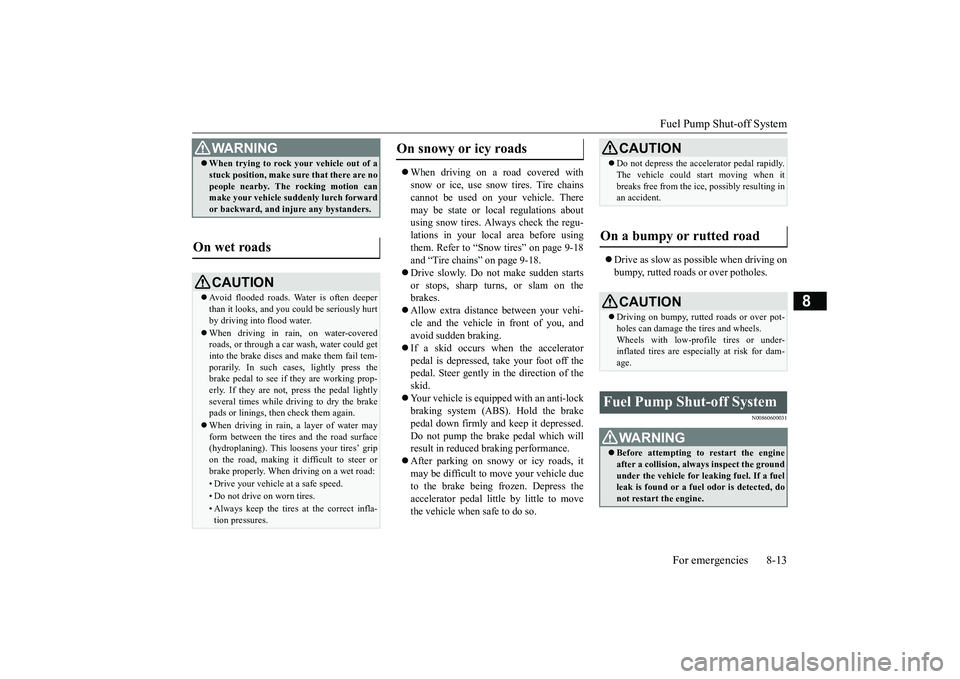
Fuel Pump Shut-off System
For emergencies 8-13
8
When driving on a road covered with snow or ice, use snow tires. Tire chains cannot be used on your vehicle. Theremay be state or local regulations about using snow tires. Always check the regu- lations in your local area before usingthem. Refer to “Snow tires” on page 9-18 and “Tire chains” on page 9-18. Drive slowly. Do not make sudden starts or stops, sharp turns, or slam on thebrakes. Allow extra distance between your vehi- cle and the vehicle in front of you, andavoid sudden braking. If a skid occurs when the accelerator pedal is depressed, take your foot off thepedal. Steer gently in the direction of the skid. Your vehicle is equipped with an anti-lock braking system (ABS). Hold the brake pedal down firmly and keep it depressed. Do not pump the brake pedal which willresult in reduced braking performance. After parking on snowy or icy roads, it may be difficult to move your vehicle dueto the brake being frozen. Depress the accelerator pedal little by little to move the vehicle when safe to do so.
Drive as slow as poss
ible when driving on
bumpy, rutted roads or over potholes.
N00860600031
WA R N I N G When trying to rock your vehicle out of a stuck position, make sure that there are no people nearby. The rocking motion can make your vehicle suddenly lurch forward or backward, and injure any bystanders.
On wet roads
CAUTION Avoid flooded roads. Water is often deeper than it looks, and you could be seriously hurt by driving into flood water. When driving in rain, on water-covered roads, or through a car wash, water could getinto the brake discs and make them fail tem- porarily. In such cases, lightly press the brake pedal to see if they are working prop-erly. If they are not, press the pedal lightly several times while driving to dry the brake pads or linings, then check them again. When driving in rain, a layer of water may form between the tires and the road surface(hydroplaning). This loosens your tires’ grip on the road, making it difficult to steer or brake properly. When driving on a wet road:• Drive your vehicle at a safe speed.• Do not drive on worn tires.• Always keep the tires at the correct infla- tion pressures.
On snowy or icy roads
CAUTION Do not depress the accelerator pedal rapidly. The vehicle could start moving when it breaks free from the ice, possibly resulting in an accident.
On a bumpy or rutted road
CAUTION Driving on bumpy, rutted roads or over pot- holes can damage the tires and wheels. Wheels with low-profile tires or under- inflated tires are especially at risk for dam-age.
Fuel Pump Shut-off System
WA R N I N G Before attempting to restart the engine after a collision, always inspect the ground under the vehicle for leaking fuel. If a fuel leak is found or a fuel odor is detected, donot restart the engine.
BK0252700US.bo
ok 13 ページ 2017年10月4日 水曜日 午後4時54分
Page 357 of 417

Fuel Pump Shut-off System 8-14 For emergencies
8
In the event of a collis
ion causing frontal air-
bag deployment, the fuel pump shut-off sys- tem will activate to stop fuel supply to the engine. Mitsubishi Motors recommends that your vehicle be inspected by an authorized Mitsubishi Motors dealer after any colli- sion.WA R N I N G
BK0252700US.bo
ok 14 ページ 2017年10月4日 水曜日 午後4時54分
Page 358 of 417
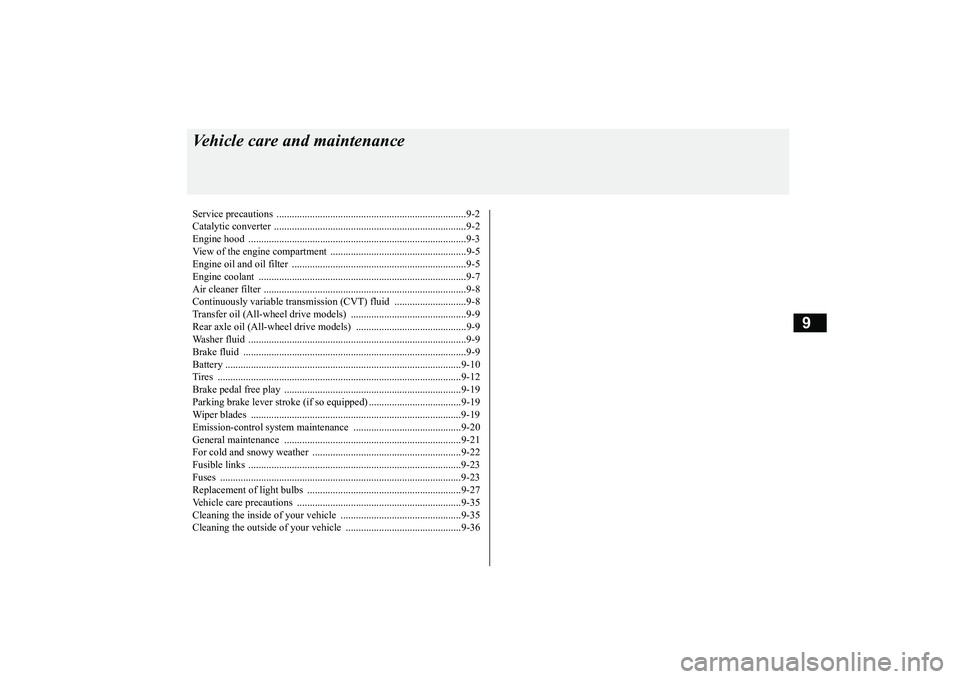
9
Vehicle care and maintenanceService precautions .........
.................................................................9-2
Catalytic converter
.................................................
..........................9-2
Engine hood ..............................
.......................................................9-3
View of the engine comp
artment .....................................................9-5
Engine oil and oil filt
er ................................
....................................9-5
Engine coolant ................
.................................................................9-7
Air cleaner filter ....
.................................................
..........................9-8
Continuously variable transmis
sion (CVT) fluid ............................9-8
Transfer oil (All-wheel dr
ive models) .............................................9-9
Rear axle oil (All-wheel dr
ive models) ...........................................9-9
Washer fluid ....................
.................................................................9-9
Brake fluid ......................
.................................................................9-9
Battery .......................................
.....................................................9-10
Tires ..........................................
.....................................................9-12
Brake pedal free play
.............................................
........................9-19
Parking brake lever stroke (if so equipped) ....................................9-19Wiper blades ...................
...............................................................9-19
Emission-control system maintenance ..........................................9-20 General maintenance
.............................................
........................9-21
For cold and snowy weat
her ..........................................................9-22
Fusible links ....................
...............................................................9-23
Fuses .........................................
.....................................................9-23
Replacement of light bu
lbs ............................................................9-27
Vehicle care precautions
........................................
........................9-35
Cleaning the inside of your
vehicle ...............................................9-35
Cleaning the outside of your
vehicle .............................................9-36
BK0252700US.bo
ok 1 ページ 2017年10月4日 水曜日 午後4時54分
Page 359 of 417
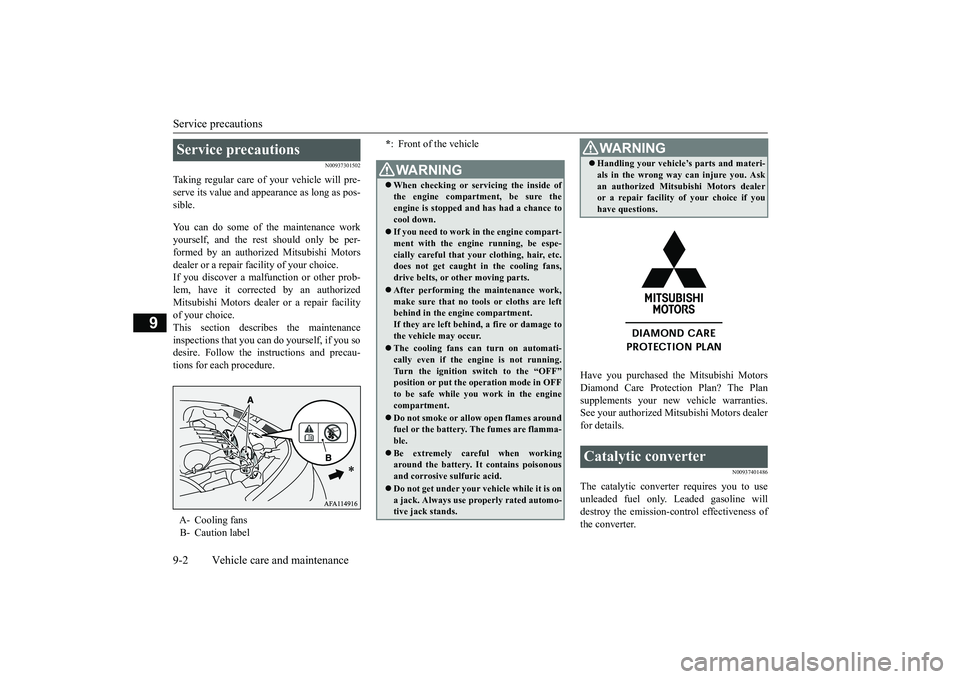
Service precautions 9-2 Vehicle care and maintenance
9
N00937301502
Taking regular care of your vehicle will pre- serve its value and appearance as long as pos-sible. You can do some of the maintenance work yourself, and the rest should only be per- formed by an authorized Mitsubishi Motorsdealer or a repair facility of your choice.If you discover a malfunction or other prob- lem, have it corrected by an authorized Mitsubishi Motors dealer or a repair facilityof your choice. This section describes the maintenance inspections that you can do yourself, if you sodesire. Follow the instructions and precau- tions for each procedure.
Have you purchased the Mitsubishi Motors Diamond Care Protection Plan? The Plan supplements your new vehicle warranties. See your authorized Mitsubishi Motors dealerfor details.
N00937401486
The catalytic converter requires you to useunleaded fuel only. Leaded gasoline will destroy the emission-control effectiveness of the converter.
Service precautions A- Cooling fansB- Caution label
* : Front of the vehicleWA R N I N GWhen checking or servicing the inside of the engine compartment, be sure the engine is stopped and has had a chance to cool down. If you need to work in the engine compart- ment with the engine running, be espe-cially careful that your clothing, hair, etc. does not get caught in the cooling fans, drive belts, or other moving parts. After performing the maintenance work, make sure that no tools or cloths are leftbehind in the engine compartment. If they are left behind, a fire or damage to the vehicle may occur. The cooling fans can turn on automati- cally even if the engine is not running.Turn the ignition switch to the “OFF” position or put the operation mode in OFF to be safe while you work in the enginecompartment. Do not smoke or allow open flames around fuel or the battery. The fumes are flamma- ble. Be extremely careful when working around the battery. It contains poisonous and corrosive sulfuric acid. Do not get under your vehicle while it is on a jack. Always use properly rated automo- tive jack stands.
Handling your vehicle’s parts and materi- als in the wrong way can injure you. Ask an authorized Mitsubishi Motors dealer or a repair facility of your choice if you have questions.
Catalytic converter
WA R N I N G
BK0252700US.bo
ok 2 ページ 2017年10月4日 水曜日 午後4時54分
Page 360 of 417
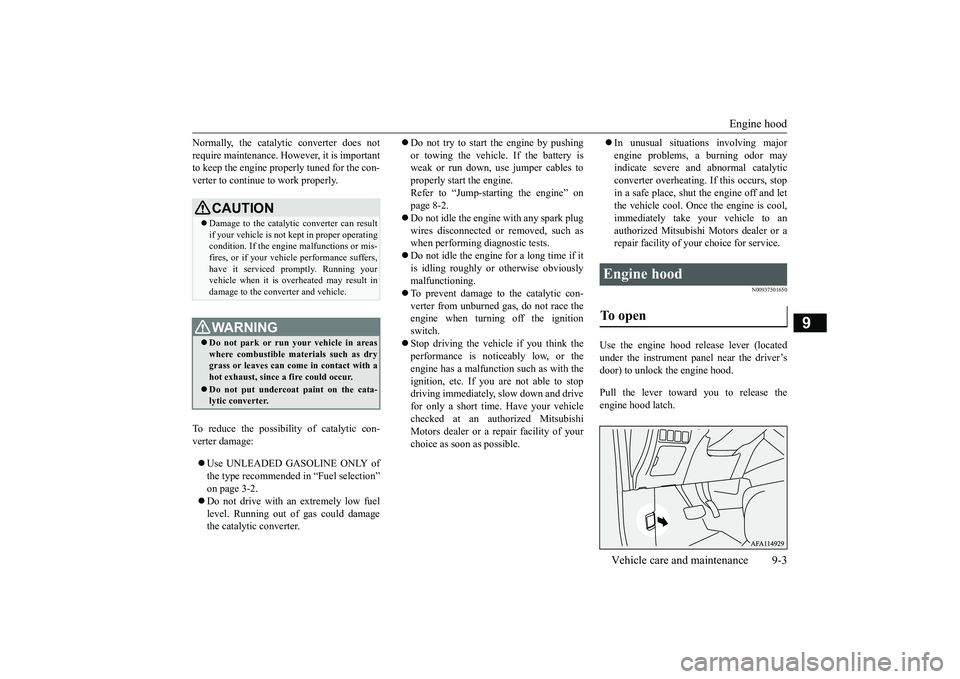
Engine hood
Vehicle care and maintenance 9-3
9
Normally, the catalytic converter does not require maintenance. However, it is important to keep the engine properly tuned for the con- verter to continue to work properly. To reduce the possibility of catalytic con- verter damage: Use UNLEADED GASOLINE ONLY of the type recommended in “Fuel selection” on page 3-2. Do not drive with an extremely low fuel level. Running out of gas could damage the catalytic converter.
Do not try to start the engine by pushing or towing the vehicle. If the battery is weak or run down, use jumper cables to properly start the engine.Refer to “Jump-starting the engine” on page 8-2. Do not idle the engine with any spark plug wires disconnected or removed, such as when performing diagnostic tests. Do not idle the engine for a long time if it is idling roughly or otherwise obviouslymalfunctioning. To prevent damage to the catalytic con- verter from unburned gas, do not race theengine when turning off the ignition switch. Stop driving the vehicle if you think the performance is noticeably low, or the engine has a malfunction such as with the ignition, etc. If you
are not able to stop
driving immediately, slow down and drive for only a short time. Have your vehicle checked at an authorized MitsubishiMotors dealer or a repair facility of your choice as soon as possible.
In unusual situations involving major engine problems, a burning odor may indicate severe and abnormal catalytic converter overheating. If this occurs, stopin a safe place, shut the engine off and let the vehicle cool. Once the engine is cool, immediately take your vehicle to anauthorized Mitsubishi Motors dealer or a repair facility of your choice for service.
N00937501650
Use the engine hood release lever (located under the instrument panel near the driver’s door) to unlock the engine hood. Pull the lever toward you to release the engine hood latch.
CAUTION Damage to the catalytic converter can result if your vehicle is not kept in proper operatingcondition. If the engine malfunctions or mis- fires, or if your vehicle performance suffers, have it serviced promptly. Running yourvehicle when it is overheated may result in damage to the converter and vehicle.WA R N I N G Do not park or run your vehicle in areas where combustible materials such as dry grass or leaves can come in contact with a hot exhaust, since a fire could occur. Do not put undercoat paint on the cata- lytic converter.
Engine hood To open
BK0252700US.bo
ok 3 ページ 2017年10月4日 水曜日 午後4時54分
Page 361 of 417
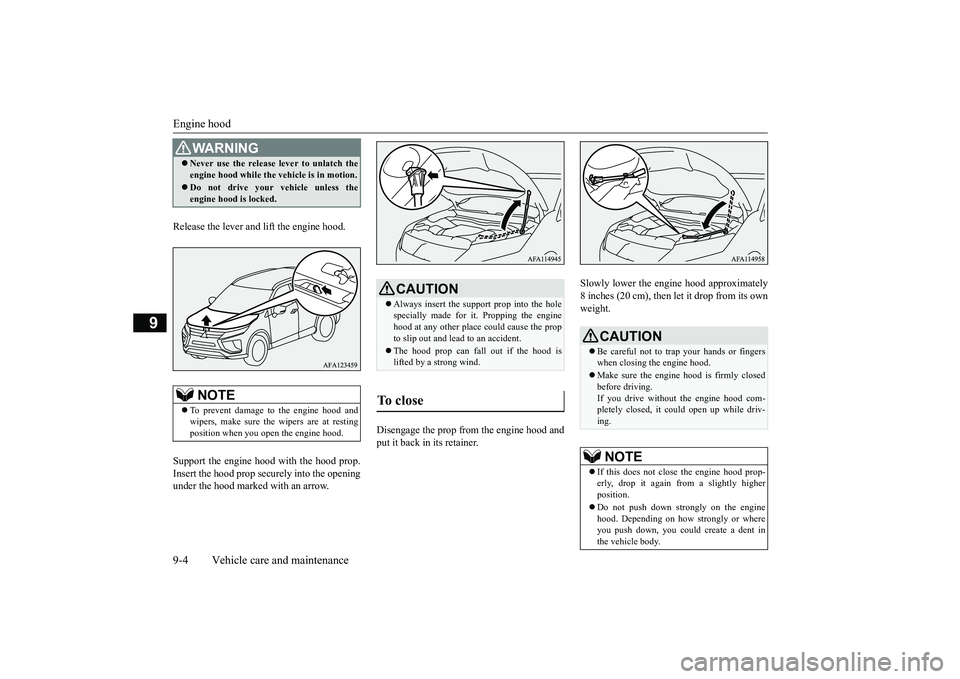
Engine hood 9-4 Vehicle care and maintenance
9
Release the lever and lift the engine hood. Support the engine hood with the hood prop. Insert the hood prop secu
rely into the opening
under the hood marked with an arrow.
Disengage the prop from the engine hood and put it back in its retainer.
Slowly lower the engine hood approximately 8 inches (20 cm), then let it drop from its ownweight.
WA R N I N G Never use the release lever to unlatch the engine hood while the vehicle is in motion. Do not drive your vehicle unless the engine hood is locked.NOTE
To prevent damage to the engine hood and wipers, make sure the wipers are at resting position when you open the engine hood.
CAUTION Always insert the support prop into the hole specially made for it. Propping the engine hood at any other place could cause the prop to slip out and lead to an accident. The hood prop can fall out if the hood is lifted by a strong wind.
To close
CAUTION Be careful not to trap your hands or fingers when closing the engine hood. Make sure the engine hood is firmly closed before driving. If you drive without the engine hood com-pletely closed, it could open up while driv- ing.NOTE
If this does not close the engine hood prop- erly, drop it again from a slightly higher position. Do not push down strongly on the engine hood. Depending on how strongly or where you push down, you could create a dent inthe vehicle body.
BK0252700US.bo
ok 4 ページ 2017年10月4日 水曜日 午後4時54分